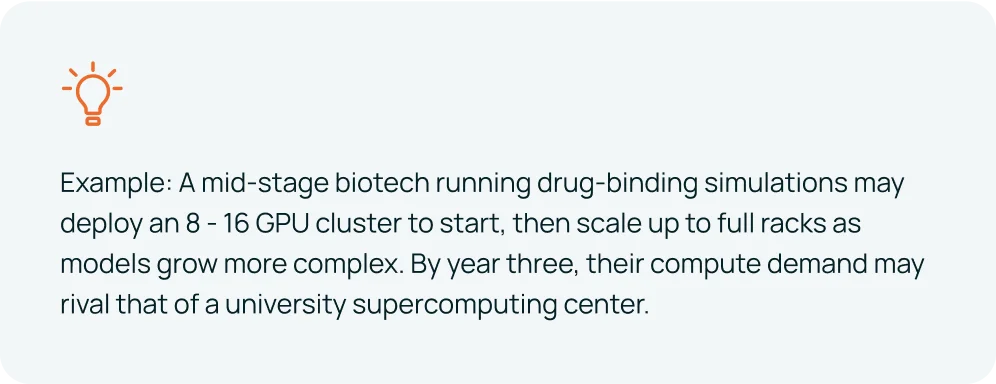AI is becoming the microscope of the modern era. Where traditional lab tools reveal cells and molecules, AI reveals patterns across genomes, patient data, and molecular structures that humans could never parse alone. But to use this microscope, biotech companies need the right foundation: AI infrastructure built for the scale and sensitivity of life sciences.
This guide explores how biotech teams can design infrastructure that supports discovery, scales with research demands, and satisfies regulatory obligations without stalling innovation.
Why biotech workloads demand more from AI infrastructure
Most companies adopt AI to save seconds on a process. Biotech uses it to save years in drug development.
AI workloads in biotech are computationally demanding: protein folding, genomic variant analysis, drug screening, clinical trial modeling, and medical imaging all require massive datasets and specialized compute. AlphaFold’s ability to predict 3D protein structures gave researchers a faster alternative to years of lab work, changing how structural biology is done. Genomic sequencing, which once took months, now produces torrents of raw data in days that must be wrangled, stored, and analyzed with AI before it becomes meaningful.
Infrastructure choices in biotech determine how quickly teams can process data, train models, and move discoveries forward.
The essential building blocks of biotech AI infrastructure
Compute power: training models and running experiments at scale
AI workloads in biotech range from training massive neural networks to analyzing countless small experiments in parallel. Both require serious computing horsepower.

Networking: moving genomic and imaging data without bottlenecks
In life sciences, data is sprawling. Whole-genome sequencing produces hundreds of gigabytes per individual. Multiply that by thousands of patients, then add in MRI scans, cryo-EM images, or electronic health records, and you’ve got pipelines that strain even robust networks.
Without robust networking, data transfer becomes the bottleneck and the lab grinds to a halt.
Storage: balancing performance with sensitive data protection
Storage systems in biotech need to combine high throughput for active analysis with strong protections for sensitive patient and research data.
.webp)
Cloud, on-prem, or hybrid: which deployment model fits biotech best?
Cloud infrastructure is the starting point for many biotech startups. It lowers the barrier to entry and provides on-demand access to powerful GPUs. For teams still validating hypotheses, the flexibility to spin up resources overnight is invaluable.
Pitfall to avoid: Using cloud for patient data without fully vetting compliance certifications. Regulatory audits can derail progress if infrastructure isn’t HIPAA or GDPR aligned.
For established biotech firms or pharma companies, on-premises infrastructure often becomes the backbone of research. Predictable, high-volume workloads justify the upfront capital.
A major pharmaceutical company might deploy high-density racks with liquid cooling to support continuous drug discovery pipelines. While costly, the infrastructure becomes a strategic asset rather than an operational burden.
The hybrid model is gaining traction because it balances control with elasticity. Sensitive patient data stays in-house, while exploratory workloads or unexpected bursts move to the cloud.
A hybrid setup is particularly useful for clinical trials: keep regulatory datasets in-house, but run large-scale machine learning experiments in the cloud during analysis peaks.
Compliance and governance: why infrastructure choices must satisfy regulators
Biotech produces sensitive, regulated data, which adds further complexity to the infrastructure equation.
Far from overhead, these safeguards are what make infrastructure credible to scientists, acceptable to regulators, and safe for patients.

How to design an AI infrastructure strategy for biotech
The right infrastructure plan starts with the science: what models you’re training, how big the datasets are, and how those needs will change as research progresses. To show how this works in practice, let’s walk through the key steps and how a hypothetical biotech startup might approach them.
1. Assess current and future needs
Every strategy starts with an inventory. What workloads will you run: training massive models, or running inference on many smaller ones? How large are your datasets today, and how fast will they grow over the next 2 - 3 years? What regulatory frameworks (HIPAA, GDPR, FDA 21 CFR Part 11) apply to your work?
2. Prioritize performance requirements
Next comes deciding what matters most: raw compute speed, storage throughput, or low-latency networking. Each biotech workload pulls in different directions: imaging analysis is storage-heavy, while molecular modeling leans on GPU compute.
3. Consider total cost of ownership
Hardware spend is only part of the equation. Energy consumption, staffing for cluster management, upgrade cycles, and scaling costs all affect long-term viability.
4. Ensure compliance and security
In biotech, compliance is non-negotiable. Data residency, patient privacy, and auditability all dictate where and how data can be stored and processed.
5. Scale in phases
The final step is accepting that infrastructure won’t be static. It should grow alongside the company’s research pipeline.
By linking each step of the strategy to a real-world decision, this framework shows how biotech companies can start fast, stay compliant, and scale responsibly. The end result is infrastructure that supports current research while paving the way for clinical and commercial readiness.
What’s next: preparing for agentic AI in biotech
AI in biotech is evolving beyond models into agentic systems that autonomously explore hypotheses, run experiments, and generate insights. These agents will require:
- Multimodal infrastructure to handle text, genomic, and imaging data together.
- On-demand orchestration across hybrid environments.
- Even stricter governance, as regulators begin scrutinizing AI decision-making itself, not just the data it processes.
The infrastructure decisions made today must anticipate these needs. Flexible, scalable systems will keep biotech companies ahead of both competitors and regulators.
Optimizing biotech AI infrastructure with WhiteFiber
AI in biotech comes with unique demands: massive genomic datasets, compute-hungry molecular simulations, and strict regulatory requirements. Building infrastructure is only the first step; the real gains come from tuning compute, storage, and networking to handle biotech workloads efficiently and within regulatory limits.
WhiteFiber’s infrastructure is purpose-built for life sciences, eliminating the inefficiencies that slow down AI-driven research at scale:
- High-speed networking: Infiniband and ultra-fast Ethernet interconnects that keep genomic and imaging data flowing without bottlenecks.
- AI-optimized storage: Architectures like VAST and WEKA tuned for multi-petabyte datasets and high-throughput access patterns common in sequencing and imaging.
- Scalable design: Infrastructure that grows seamlessly from pilot clusters to enterprise-grade systems, ensuring smooth expansion as workloads intensify.
- Compliance-first architecture: Secure data residency, audit-ready pipelines, and governance controls to satisfy HIPAA, GDPR, and FDA requirements.
- Hybrid flexibility: Unified solutions for on-premises and cloud, giving research teams cost predictability with burst capacity on demand.
- End-to-end observability: Intelligent monitoring and orchestration to maximize GPU utilization and minimize waste — from protein modeling to clinical trial analysis.
With WhiteFiber, biotech organizations don’t have to choose between agility, compliance, and performance. You get infrastructure that’s faster, leaner, and built to evolve with your research ambitions.

FAQs: AI infrastructure for biotech



.webp)
.webp)
.webp)